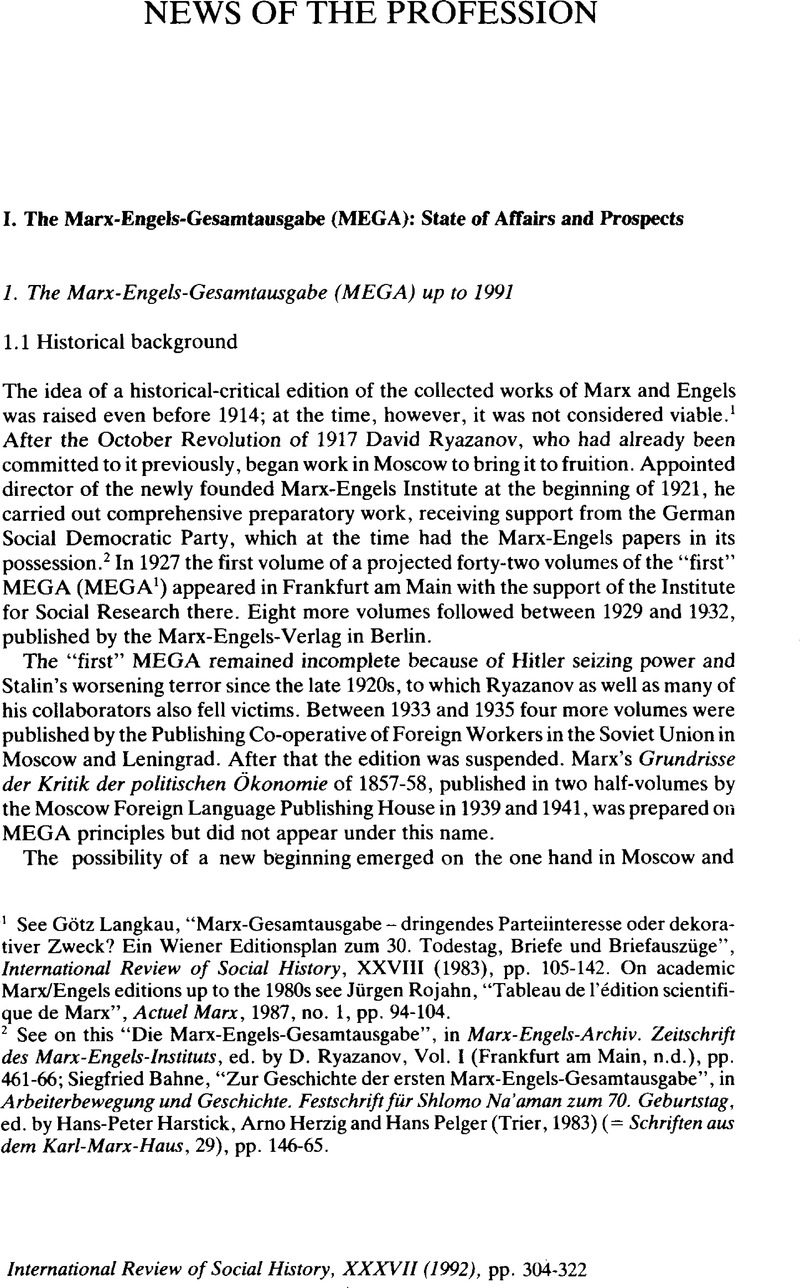No CrossRef data available.
Article contents
News of the Profession
Published online by Cambridge University Press: 18 December 2008
Abstract

- Type
- News of the Profession
- Information
- Copyright
- Copyright © Internationaal Instituut voor Sociale Geschiedenis 1992
References
2 See on this “Die Marx-Engels-Gesamtausgabe”, in Marx-Engels-Archiv. Zeitschrift des Marx-Engels-Instituts, ed. by Ryazanov, D., Vol. I (Frankfurt am Main, n.d.), pp. 461–66;Google ScholarSiegfried, Bahne, “Zur Geschichte der ersten Marx-Engels-Gesamtausgabe”, in Arbeiterbewegung und Geschichte. Festschrift für Shlomo Na'aman zum 70. Geburtstag, ed. by Hans-Peter, Harstick, Arno, Herzig and Hans, Pelger (Trier, 1983).Google ScholarSchriften aus dem Karl-Marx-Haus, 29), pp. 146–65.Google Scholar
3 See on this Paul, Mayer, “Die Geschichte des sozialdemokratischen Parteiarchivs und das Schicksal des Marx-Engels-Nachlasses”, Archiv für Sozialgeschichte, VI/VII (Hanover, 1966/1967), pp. 5–198, especially pp. 79 ff.;Google ScholarMaria, Hunink, De papieren van de revolutie: het Internationaal Instituut voor Sociale Geschiedenis 1935–1947 (Amsterdam, 1986), especially pp. 52ff.Google Scholar
4 Texts earlier attributed to Marx or Engels later caused difficulties; for example, the article “Luther als Schiedsrichter zwischen Strauβ und Feuerbach” was eliminated after critical textual studies.
5 Karl Marx, Friedrich Engels: Gesamtausgabe (MEGA). Editionsgrundsätze und Probestücke (Berlin, 1972). The volume was edited by Rolf, Dlubek and Malysch, A. I. (directors), Erich, Kundel, Lewiowa, S.S., Richard, Sperl and Inge, Taubert.Google Scholar
6 A considerable amount of material is available on this and is accessible to interested parties.
7 Editionsrichtlinien der Marx-Engels-Gesamtausgabe (MEGA) (hectograph, Berlin, 1976). The guidelines were expanded or modified by twenty-five supplements up to 1984.Google Scholar
8 Some volumes (I/21, II/1, II/3, II/4) appeared in several parts. These partial volumes are no different in appearance from the full volumes.
9 In preparing the edition of marginalia proposed for a later stage, a sample volume was published in 1983 in order to stimulate international discussion concerning the editorial principles to be applied: Karl Marx, Friedrich Engels: Gesamlausgabe (MEGA). Vierte Abteilung. Marginalien. Probestücke (Berlin, 1983).Google Scholar About thirty depositions were received from academic institutions, libraries, publishers and individual scholars. In addition, a one-day editorial colloquium on the sample volume was organized by the Textology Group at the Central Institute for the History of Literature of the Academy of Sciences in Berlin (Siegfried Scheibe).
10 The edition carries the following uniform overall title: Karl Marx, Friedrich Engels: Gesamtausgabe (MEGA). Until 1989 the publishing institutes' imprint read Herausgegeben vom Institut für Marxismus beim Zentralkomitee der Kommunistischen Partei der Sowjetunion und vom Institut für Marxismus-Leninismus beim Zentralkomitee der Sozialistischen Einheitspartei Deutschlands. In 1990 two volumes (I/29, II/9) carried the following: Herausgegeben vom Institut für Geschichte der Arbeiterbewegung Berlin und vom Institut für Marxismus-Leninismus beim Zentralkomitee der Kommunistischen Partei der Sowjetunion. A further volume (III/8) appeared without any imprint. Since October 1990 the following has appeared on the title page: Herausgegeben von der Internationalen Marx-Engels-Stiftung. All the volumes were published by Dietz Verlag in Berlin.
11 See in particular Fred, E. Schrader, “Karl Marx – Forschung oder Denkmalpflege”, IWK, XVI (1980), pp. 398–403;Google ScholarJürgen, Rojahn, “Die Marxschen Manuskripte aus dem Jahre 1844 in der neuen Marx-Engels-Gesamtausgabe (MEGA)”, Archiv für Sozialgeschichte, XXV (Bonn-Bad Godesberg, 1985), pp. 647–63.Google Scholar
12 From the very beginning our idea has been that further MEGA work in Germany should be largely concentrated in a MEGA working group at the Berlin AS, with possibly a second smaller group at the Saxonian AS. As regard staff, comparable academic editions should be taken as examples; there are eighteen full-time collaborators working on the Leibniz Edition for instance.
13 The Équipe de Recherche en Civilisation Allemande at the Université de Provence, supported by the Centre National de la Recherche Scientifique (CNRS).
14 The introductions had to be approved by the directors of the two IMLs; the introductions were required to establish a link between the works of Marx and Engels and those of Lenin and to demonstrate the unity of the various elements of marxismleninism.


